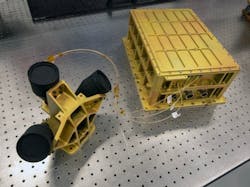NASA's laser navigation tech enables commercial lunar exploration
WASHINGTON - Later this month, NASA’s commercial lunar delivery services provider Intuitive Machines will launch its Nova-C lunar lander carrying several NASA science and technology payloads, including the Navigation Doppler Lidar (NDL). This innovative guidance system, developed by NASA’s Langley Research Center in Hampton, Virginia, under the agency’s Space Technology Mission Directorate (STMD), can potentially revolutionize landing spacecraft on extraterrestrial worlds, Simone Williams writes for NASA's Langley Research Center. Continue reading original article.
The Military & Aerospace Electronics take:
6 February - Williams writes that the NDL project started when NASA's Dr. Farzin Amzajerdian was working to put landers down on Mars in precise locations, and radar was inherently too imprecise.
“Why not use a lidar instead of a radar?” he asked.
"LiDAR, which stands for light detection and ranging, is a technology that uses visible or infrared light the same way radar uses radio waves," Williams writes. "Lidar sends laser pulses to a target, which reflects some of that light back onto a detector. As the instrument moves in relation to its target, the change in frequency of the returning signal – also known as the Doppler effect – allows the lidar to measure velocity directly and precisely. Distance is measured based on the travel time of the light to the target and back."
Jamie Whitney, Senior Editor
Military + Aerospace Electronics
